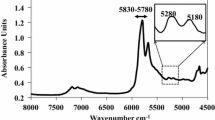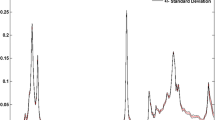Abstract
In this work, blends of olive and soybean oils were analyzed by near-infrared spectroscopy (NIR), mid-infrared (MIR), and Raman techniques to evaluate adulterations in olive oils. A representative group of different commercial brands of soybean oil and extra-virgin olive oil were analyzed by gas chromatography with flame ionization detector in order to explore the chemical similarity and composition of the fatty acid (FA) profile. Two stock solutions were prepared, one produced from a mixture of soybean oils and the other from the mixture of olive oils. From these stock solutions, 60 samples were prepared, simulating adulteration levels of extra-virgin olive oil with soybean oil between 0 and 100 %. It was possible to fit a model able to predict fraud within the interval investigated by partial least squares regression approach, with precision and accuracy values for root mean squared error of prediction of 1.76 (NIR), 4.89 (MIR), and 1.57 (Raman) and coefficient of determination R 2 greater than 0.98 for the three techniques. The methodologies demonstrated to be very useful for the quantification of extra-virgin olive oil adulteration with soybean oil, presenting short analysis time, low cost, and absence of sample preparation procedures as main advantages.




Similar content being viewed by others
References
Afseth NK, Segtnan VH, Marquardt BJ, Wold JP (2005) Raman and near-infrared spectroscopy for quantification of fat composition in a complex food model system. Appl Spectrosc 59:1324–1332. doi:10.1366/000370205774783304
Afseth NK, Wold JP, Segtnan VH (2006) The potential of Raman spectroscopy for characterisation of the fatty acid unsaturation of salmon. Analytica Chimica Acta 572:85–92. doi:10.1016/j.aca.2006.05.013
AOCS (reapproved 1997, “revised 2001”) Determination of cis- and trans- fatty acids in hydrogenated and refined oils and fats by capillary GLC
Aparicio R, Morales MT, Aparicio-Ruiz R, Tena N, García-González DL (2013) Authenticity of olive oil: mapping and comparing official methods and promising alternatives. Food Research International 54:2025–2038. doi:10.1016/j.foodres.2013.07.039
Becerra-Herrera M, Sánchez-Astudillo M, Beltrán R, Sayago A (2014) Determination of phenolic compounds in olive oil: new method based on liquid–liquid micro extraction and ultra high performance liquid chromatography–triple–quadrupole mass spectrometry LWT. Food Science and Technology 57:49–57. doi:10.1016/j.lwt.2014.01.016
Cajka T, Riddellova K, Klimankova E, Cerna M, Pudil F, Hajslova J (2010) Traceability of olive oil based on volatiles pattern and multivariate analysis. Food Chemistry 121:282–289. doi:10.1016/j.foodchem.2009.12.011
Campbell GP, Curran JM (2009) The interpretation of elemental composition measurements from forensic glass evidence III. Science & Justice 49:2–7. doi:10.1016/j.scijus.2008.09.001
Christie WW, Han X (2012) Chapter 7—preparation of derivatives of fatty acids. In: Christie WW, Han X (eds) Lipid analysis, 4th edn. Woodhead, pp 145–158. doi:10.1533/9780857097866.145
Christy AA, Kasemsumran S, Du Y, Ozaki Y (2004) The detection and quantification of adulteration in olive oil by near-infrared spectroscopy and chemometrics. Analytical Sciences 20:935–940. doi:10.2116/analsci.20.935
D’Angelo S et al (2005) Hydroxytyrosol, a natural antioxidant from olive oil, prevents protein damage induced by long-wave ultraviolet radiation in melanoma cells. Free Radical Biology and Medicine 38:908–919. doi:10.1016/j.freeradbiomed.2004.12.015
Dais P, Hatzakis E (2013) Quality assessment and authentication of virgin olive oil by NMR spectroscopy: a critical review. Analytica Chimica Acta 765:1–27. doi:10.1016/j.aca.2012.12.003
Delmonte P, Fardin Kia A-R, Kramer JKG, Mossoba MM, Sidisky L, Rader JI (2011) Separation characteristics of fatty acid methyl esters using SLB-IL111, a new ionic liquid coated capillary gas chromatographic column. Journal of Chromatography A 1218:545–554. doi:10.1016/j.chroma.2010.11.072
Fassel VA (1976) International Union of Pure and Applied Chemistry. Analytical Chemistry Division. Commission on Spectrochemical and Other Optical Procedures for Analysis. Nomenclature, symbols, units and their usage in spectrochemical analysis. II. Data interpretation. Analytical Chemistry 48:2294–2294. doi:10.1021/ac50008a068
Franco MN et al (2014) Phenolic compounds and antioxidant capacity of virgin olive oil. Food Chemistry 163:289–298. doi:10.1016/j.foodchem.2014.04.091
Geladi P, Kowalski BR (1986) Partial least-squares regression: a tutorial. Analytica Chimica Acta 185:1–17. doi:10.1016/0003-2670(86)80028-9
Guillén MD, Cabo N (1997) Characterization of edible oils and lard by Fourier transform infrared spectroscopy. Relationships between composition and frequency of concrete bands in the fingerprint region. J Amer Oil Chem Soc 74:1281–1286. doi:10.1007/s11746-997-0058-4
Guzmán E, Baeten V, Fernández Pierna JA, García-Mesa JA (2011) Application of low-resolution Raman spectroscopy for the analysis of oxidized olive oil. Food Control 22:2036–2040. doi:10.1016/j.foodcont.2011.05.025
Hotelling H (1931) The generalization of Student’s ratio. The Annals of Mathematical Statistics 2:360–378. doi:10.2307/2957535
Jolliffe IT (2002) Principal component analysis. Springer series in statistics. Springer
Lamy S, Ouanouki A, Béliveau R, Desrosiers RR (2014) Olive oil compounds inhibit vascular endothelial growth factor receptor-2 phosphorylation. Experimental Cell Research 322:89–98. doi:10.1016/j.yexcr.2013.11.022
López-Díez EC, Bianchi G, Goodacre R (2003) Rapid quantitative assessment of the adulteration of virgin olive oils with hazelnut oils using Raman spectroscopy and chemometrics. Journal of Agricultural and Food Chemistry 51:6145–6150. doi:10.1021/jf034493d
Lopez S et al (2014) Membrane composition and dynamics: a target of bioactive virgin olive oil constituents. Biochimica et Biophysica Acta (BBA)—Biomembranes 1838:1638–1656. doi:10.1016/j.bbamem.2014.01.007
Lorencini M, Brohem CA, Dieamant GC, Zanchin NIT, Maibach HI (2014) Active ingredients against human epidermal aging. Ageing Research Reviews 15:100–115. doi:10.1016/j.arr.2014.03.002
Ma W, Tang C-H, Yin S-W, Yang X-Q, Wang Q, Liu F, Wei Z-H (2012) Characterization of gelatin-based edible films incorporated with olive oil. Food Research International 49:572–579. doi:10.1016/j.foodres.2012.07.037
Mailer R (2004) Rapid evaluation of olive oil quality by NIR reflectance spectroscopy. J Amer Oil Chem Soc 81:823–827. doi:10.1007/s11746-004-0986-4
Marcos B, Sárraga C, Castellari M, Kappen F, Schennink G, Arnau J (2014) Development of biodegradable films with antioxidant properties based on polyesters containing α-tocopherol and olive leaf extract for food packaging applications. Food Packaging and Shelf Life 1:140–150. doi:10.1016/j.fpsl.2014.04.002
Mba O, Adewale P, Dumont M-J, Ngadi M (2014) Application of near-infrared spectroscopy to characterize binary blends of palm and canola oils. Industrial Crops and Products 61:472–478. doi:10.1016/j.indcrop.2014.07.037
Moore JC, Spink J, Lipp M (2012) Development and application of a database of food ingredient fraud and economically motivated adulteration from 1980 to 2010. Journal of Food Science 77:R118–R126. doi:10.1111/j.1750-3841.2012.02657.x
Moros J, Garrigues S, Mdl G (2010) Vibrational spectroscopy provides a green tool for multi-component analysis. TrAC Trends in Analytical Chemistry 29:578–591. doi:10.1016/j.trac.2009.12.012
Olsen EF, Rukke E-O, Flåtten A, Isaksson T (2007) Quantitative determination of saturated-, monounsaturated- and polyunsaturated fatty acids in pork adipose tissue with non-destructive Raman spectroscopy. Meat Science 76:628–634. doi:10.1016/j.meatsci.2007.02.004
Özdemir D, Öztürk B (2007) Near infrared spectroscopic determination of olive oil adulteration with sunflower and corn oil. Journal of Food and Drug Analysis 15:40–47
Pereda M, Dufresne A, Aranguren MI, Marcovich NE (2014) Polyelectrolyte films based on chitosan/olive oil and reinforced with cellulose nanocrystals. Carbohydrate Polymers 101:1018–1026. doi:10.1016/j.carbpol.2013.10.046
Portarena S, Gavrichkova O, Lauteri M, Brugnoli E (2014) Authentication and traceability of Italian extra-virgin olive oils by means of stable isotopes techniques. Food Chemistry 164:12–16. doi:10.1016/j.foodchem.2014.04.115
Priore P, Siculella L, Gnoni GV (2014) Extra virgin olive oil phenols down-regulate lipid synthesis in primary-cultured rat-hepatocytes. The Journal of Nutritional Biochemistry 25:683–691. doi:10.1016/j.jnutbio.2014.01.009
Rohman A, Che Man YB (2011) The use of Fourier transform mid infrared (FT-MIR) spectroscopy for detection and quantification of adulteration in virgin coconut oil. Food Chemistry 129:583–588. doi:10.1016/j.foodchem.2011.04.070
Soltanipoor F, Delaram M, Taavoni S, Haghani H (2012) The effect of olive oil on prevention of striae gravidarum: a randomized controlled clinical trial. Complementary Therapies in Medicine 20:263–266. doi:10.1016/j.ctim.2012.05.001
Valenzuela C, Abugoch L, Tapia C (2013) Quinoa protein–chitosan–sunflower oil edible film: mechanical, barrier and structural properties. LWT - Food Science and Technology 50:531–537. doi:10.1016/j.lwt.2012.08.010
Wold S, Geladi P, Esbensen K, Öhman J (1987) Multi-way principal components—and PLS—analysis. Journal of Chemometrics 1:41–56. doi:10.1002/cem.1180010107
Zhang X-F, Zou M-Q, Qi X-H, Liu F, Zhang C, Yin F (2011) Quantitative detection of adulterated olive oil by Raman spectroscopy and chemometrics. Journal of Raman Spectroscopy 42:1784–1788. doi:10.1002/jrs.2933
Zou M-Q et al (2009) Rapid authentication of olive oil adulteration by Raman spectrometry. Journal of Agricultural and Food Chemistry 57:6001–6006. doi:10.1021/jf900217s
Acknowledgments
The authors are thankful to the Brazilian agencies CAPES, CNPQ, and FAPEMIG for financial support.
Conflict of Interest
Thiago de Oliveira Mendes declares that he has no conflict of interest. Roney Alves da Rocha declares that he has no conflict of interest. Brenda Lee Simas Porto declares that she has no conflict of interest. Marcone Augusto Leal de Oliveira declares that he has no conflict of interest. Virgílio de Carvalho dos Anjos declares that he has no conflict of interest. Maria Jose Valenzuela Bell declares that she has no conflict of interest. This article does not contain any studies with human or animal subjects.
Author information
Authors and Affiliations
Corresponding author
Rights and permissions
About this article
Cite this article
Mendes, T.O., da Rocha, R.A., Porto, B.L.S. et al. Quantification of Extra-virgin Olive Oil Adulteration with Soybean Oil: a Comparative Study of NIR, MIR, and Raman Spectroscopy Associated with Chemometric Approaches. Food Anal. Methods 8, 2339–2346 (2015). https://doi.org/10.1007/s12161-015-0121-y
Received:
Accepted:
Published:
Issue Date:
DOI: https://doi.org/10.1007/s12161-015-0121-y




